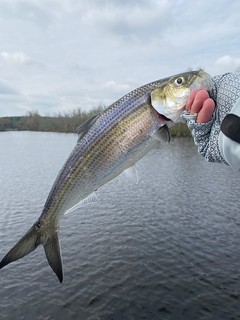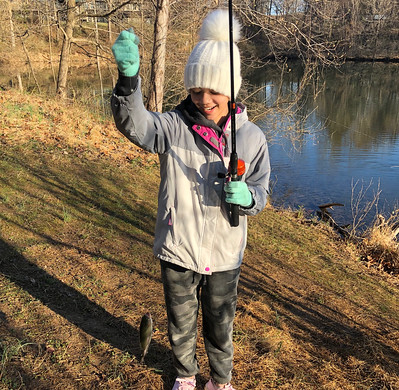Emma Ka enjoyed catching a rainbow trout at Halcyon Pond near Gaithersburg recently. Photo courtesy of Emma Ka
Warm spring temperatures are inviting anglers of all ages to step into the outdoors and enjoy wonderful fishing opportunities. Many of the community ponds near suburban areas hold excellent populations of stocked trout and other species, and provide a perfect fishing environment for our younger anglers.
A reminder to all anglers that striped bass fishing and targeting is closed throughout the Chesapeake Bay and its tidal tributaries, and will reopen on May 1. For more information on striped bass seasons and closure areas, please visit the department’s striped bass maps page.

John Horgan shows off two blue catfish he caught near Port Deposit that are destined for the dinner table. Photo by John Horgan
Now that all fishing for striped bass is closed on the Susquehanna Flats and the entire upper bay, anglers are focusing on other species. (There is no targeting of striped bass allowed until May 1). The Susquehanna River area and the Chester River hold large populations of blue catfish, there are flathead catfish in the Conowingo Dam pool, and channel catfish can be found in all of the tidal rivers. All these catfish can be caught by using fresh cut bait of gizzard shad or white perch and a bottom rig. In a pinch, clam snouts, chicken liver, and nightcrawlers will also make good baits.
White perch are beginning to show up in the lower Susquehanna River, one of the last rivers in Maryland where they are spawning. The cold water coming down from the Conowingo Dam is responsible for the delay. Right now there is very little flow coming from the dam so waters may be on an advanced schedule of warming.
The low flows from the dam are also causing the waters of the lower Susquehanna to be clear, low, and slightly warmer. This may be good news for those anticipating the arrival of American shad near the dam and hickory shad at Deer Creek and Octoraro Creek. The catch-and-release fishery for hickory shad is a very popular event, and often the spawning runs fluctuate depending on whether it’s sunny or rainy. For anglers who travel considerable distances, this fluctuation can be very unnerving. The mouth of Deer Creek is where most of the action takes place for those wearing waders and casting shad darts, small spoons, and colorful flies.
The total closure of any form of fishing for striped bass until May 1 has anglers looking to other options. Hickory shad are to be found in the upper reaches of the Choptank River, and post-spawn white perch are descending the Tuckahoe and Choptank, headed for their summer haunts. The Choptank, Tuckahoe, and Severn rivers are holding populations of channel catfish and the Choptank also has blue catfish. Finally, the creeks and rivers of lower Dorchester County are providing excellent fishing for northern snakeheads.

Herb Floyd holds up a hickory shad he caught and released while fishing on the Chicamicomico River. Photo by Herb Floyd
Hickory shad can be found from the Greensboro area up to Red Bridges. The Greensboro area offers one of the nicest places to fish, especially from shore. Red Bridges represents the end of the road for the hickory shad, but overhead tree limbs and those lying below the surface offer a challenge. Shad darts and small spoons offer the best options for spinning gear, and colorful flies for those who are fly fishing, and who will find they are limited to roll casts for the most part.
White perch can be found in the middle sections of the Choptank River. Fishing with pieces of bloodworm on a bottom rig is perhaps the best way to target them. The larger white perch were the first to spawn and will be found closer to the mouth of the river.
Fishing for channel catfish is always a fun venture in the tidal rivers on a variety of baits — including fresh cut white perch, chicken liver, nightcrawlers, and clam snouts — are all good choices. When fishing for blue catfish in the region from the mouth of the Tuckahoe to the Dover Bridge, fresh cut bait of white perch or gizzard shad is the best choice. Anglers must remember to use circle hooks when fishing with bait in the tidal rivers and especially in the Choptank River. It is illegal to fish bait with J-style hooks with more than a half-inch gap until May 1.
Striped bass are in the middle Choptank River and are actively spawning this week. Care must be taken to avoid inadvertently hooking a striped bass and if you do, please release it while still in the water.
The northern snakehead fishery in the lower Dorchester County creeks and tidal rivers is in full gear. Predicted warm weather will push this fishery further along. Casting white or pearl paddle tails with wide-gap weighted keel hooks is one of the best ways to fish for them. Rig your paddle tail weedless so you can get in tight to sunken brush where the snakeheads like to lurk. Although not cheap, a keel hook with a spiral bait holder fastened to the eye of the hook offers the best retention of your bait when dragging it over sunken brush. Dead-sticking a rod with a large minnow under a bobber is a great way to add further chances of catching a snakehead.
The striped bass spawn is right on schedule this week in the Potomac, Patuxent, and Nanticoke rivers. Those fishing in any of the tidal rivers for catfish must use circle hooks until May 1 when using bait. The only exception is if one is using a J style hook with a gap of less than a half-inch for fish such as crappie or white perch.

Don Ziers holds up an American shad for a picture before releasing it back into the Potomac River. Photo by Dennis Fleming
There are plenty of blue catfish to be found in the tidal Potomac, Patuxent, and Nanticoke rivers this week and conditions could hardly be better for targeting them. The rivers have warmed up enough to cause them to be very active along channel edges during the daytime hours. It does not take rocket science to catch them, just some stout tackle and some fresh bait. Stout tackle is a good idea since a fair number of the blue catfish being encountered can weigh 40 pounds or more. Fresh gizzard shad or white perch make ideal baits when combined with large circle hooks and enough weight to hold bottom. Channel catfish can be found in these same rivers and most every other tidal river within the region.
The tidal Potomac within the boundaries of the District of Columbia continues to be a very popular place to enjoy the exciting catch-and-release action with hickory shad and also American shad. Large numbers of hickory shad have arrived in the past week and the action is at its peak, so anglers are urged not to miss this event. This section of the river is easily fished from kayaks or one can rent a rowboat at Fletcher’s Landing. Fishing from shore is easily done but the best spots tend to be taken rather quickly. Casting shad darts of enough weight to get close to the bottom in the strong current is necessary and fishing with tandem rigged shad darts or tying in a small spoon is very common. Although not as common as the hickory shad, larger American shad are also part of the mix.
Fishing for trout remains good in most of the trout management waters this week, as water conditions are ideal. The action in the put-and-take areas will shift into high gear next week with the advent of what is called a trout stocking blast. Trout stocking crews will be placing a lot of trout from April 19 to April 30. COVID restrictions are forcing only one person per stocking vehicle so it will be a major effort to get the fish out. Crews also may not use volunteers to spread the trout out over wider areas, so anglers may experience greater numbers of trout near access locations. Be sure to check the trout stocking website next week to receive updates. The stockings will be posted after they occur.
Anglers at Deep Creek Lake will see the walleye season open April 16, with a daily limit of 5 fish per day. Many will be trolling Rapala type lures along deep rocky and grass edges. Drifting minnows down deep is also another popular way to fish for walleyes, with an added chance for large yellow perch and smallmouth bass. Floating docks are becoming more numerous each week and they provide great cover for largemouth bass to lurk in the shade.
The upper Potomac River is in fine shape this week and walleye and smallmouth bass can be caught in the early morning and evening hours on deep diving crankbaits, tubes, and jigs in current breaks and deep eddies.
The tidal Potomac largemouth bass fishery is entering its spawning phase this week. Male largemouth bass have carved out spawning beds in the shallower areas along shorelines and in the creeks in hopes of luring a female. The female largemouth bass are feeding aggressively and of course are usually carrying a heavy load, so great care should be taken in releasing them carefully.
The Maryland Department of Natural resources has partnered with Virginia and Washington D.C. and have tagged more than 300 adult largemouth bass to help monitor the population from the tidal Potomac River. Anglers can report tagged bass by calling 1-800-376-2925, or by email to basstag@dwr.virginia.gov, or by mobile survey to the department’s Volunteer Angler Survey.

Photo by Monty Hawkins
Anglers are enjoying good surf fishing opportunities along the beaches of Ocean City and Assateague Island. Black drum are being caught on a variety of baits such as clams, sand fleas. and cut bait. Most of the black drum are in the 10-pound to 20-pound range, which makes for good eating.
Flounder are beginning to slowly show up at the Ocean City Inlet, the vanguard of the spring migration. Although catches are relatively sparse, they do offer some action for those who love their flounder fishing.
Tautog fishing at the offshore wreck and reef sites continues to be very good. Some of the tautog being caught are in the double digit weight category. Captains do report that sometimes they are required to move from site to site to find the best bite for their anglers.
Finally, a reminder to all coastal anglers that circle hooks are required for bait fishing when targeting striped bass in the coastal bays around Ocean City and in the Atlantic ocean. The length and bag limits and the season for striped bass in the Atlantic Ocean and coastal bays are different from the Chesapeake Bay seasons and limits. Anglers may keep one striped bass per person per day from the Atlantic Ocean, its coastal bays, and their tributaries. The striped bass must be at least 28 inches and less than 35 inches in length.
“Wet boots are a way of life” — Austin McPherson
Maryland Fishing Report is written and compiled by Keith Lockwood, Maryland Department of Natural Resources fisheries biologist.
Click Before You Cast is written by Tidewater Ecosystem Assessment Director Tom Parham.
This report is now available on your Amazon Echo device — just ask Alexa to “open Maryland Fishing Report.”
Credit: Source link































